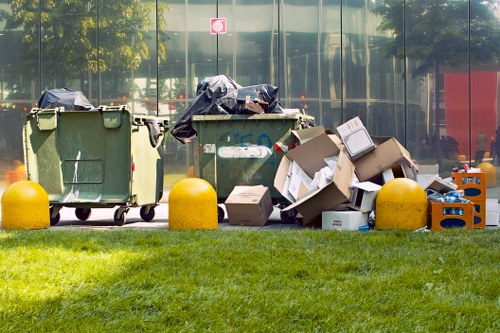Comprehensive Guide to Site Clearance in Belmont

Site clearance is a crucial first step in any construction or renovation project in Belmont. It involves the removal of debris, vegetation, and any existing structures to prepare the land for development. Proper site clearance ensures a smooth workflow, minimizes potential hazards, and sets the foundation for a successful project.
Understanding the nuances of site clearance can save time and resources. Whether you're planning to build a new home, commercial property, or undertake infrastructure projects, knowing the right techniques and regulations in Belmont is essential.
In Belmont, site clearance is not just about clearing the land; it's about preparing it in an environmentally responsible manner. This includes managing waste, preserving natural resources, and adhering to local regulations.
Why Site Clearance is Essential

Site clearance in Belmont is more than just removing unwanted materials. It lays the groundwork for the entire construction process, impacting everything from project timelines to environmental sustainability.
Proper site clearance:
- Ensures safety by removing hazardous materials.
- Prepares the ground for foundation work.
- Helps in complying with local regulations and zoning laws.
- Reduces the risk of project delays due to unforeseen obstacles.
Moreover, efficient site clearance can lead to cost savings by preventing potential issues down the line.
Key Steps in Site Clearance

The process of site clearance in Belmont typically involves several key steps to ensure that the land is adequately prepared for construction.
- Assessment and Planning: Evaluating the site to determine the extent of clearance required, including identifying any structures or vegetation that need to be removed.
- Obtaining Permits: Securing necessary permits from local authorities to comply with zoning laws and environmental regulations.
- Debris Removal: Clearing away existing buildings, trees, and other obstacles using specialized machinery.
- Grading and Leveling: Ensuring the land is even and suitable for construction.
- Waste Management: Proper disposal of cleared materials in an environmentally responsible manner.
Each of these steps requires careful planning and execution to ensure the project proceeds smoothly.
Environmental Considerations

In Belmont, environmental sustainability is a significant concern during site clearance. Responsible site clearance practices help in preserving the local ecosystem and minimizing the environmental footprint of construction projects.
Key environmental considerations include:
- Waste Recycling: Recycling materials wherever possible to reduce landfill waste.
- Preserving Topsoil: Protecting the topsoil to maintain soil fertility for future landscaping.
- Minimizing Soil Erosion: Implementing measures to prevent soil erosion during and after clearance.
- Protecting Flora and Fauna: Ensuring that local wildlife and plant species are not adversely affected by the clearance activities.
Adhering to these practices not only benefits the environment but also enhances the reputation of the construction project and the stakeholders involved.
Regulatory Compliance in Belmont

Complying with local regulations is paramount during site clearance. Belmont has specific zoning laws and environmental regulations that must be adhered to, ensuring that the clearance process is legal and minimizes adverse impacts.
Key regulatory aspects include:
- Zoning Laws: Understanding land use zoning to ensure that the intended construction is permissible.
- Environmental Permits: Obtaining necessary permits related to environmental conservation, waste management, and pollution control.
- Safety Regulations: Adhering to occupational safety standards to protect workers and the public.
- Heritage Conservation: Preserving any historical or culturally significant structures or sites on the land.
Non-compliance can lead to legal penalties, project delays, and increased costs, making it essential to work with professionals who are well-versed in Belmont's regulations.
Choosing the Right Site Clearance Service

Selecting a reliable and experienced site clearance service in Belmont is crucial for the success of your project. A competent service provider will ensure that the clearance is done efficiently, safely, and in compliance with all regulations.
When choosing a site clearance company, consider the following factors:
- Experience: Look for companies with a proven track record in site clearance projects similar to yours.
- Equipment: Ensure that the company has the necessary machinery and technology to handle the clearance effectively.
- Reputation: Check reviews and testimonials to gauge the company's reliability and quality of work.
- Compliance: Verify that the company adheres to all local regulations and environmental standards.
- Pricing: Obtain detailed quotes to understand the cost structure and ensure it fits within your budget.
Investing time in selecting the right service provider can lead to smoother project execution and better overall outcomes.
Cost Factors in Site Clearance

The cost of site clearance in Belmont can vary based on several factors. Understanding these factors can help in budgeting and avoiding unexpected expenses during your project.
- Site Size: Larger sites require more time and resources to clear, increasing costs.
- Land Conditions: Rocky, uneven, or forested land may require specialized equipment and additional labor.
- Debris Volume: The amount of debris and existing structures influences the clearance effort and cost.
- Access to Site: Difficult-to-reach sites may incur higher transportation and machinery costs.
- Regulatory Fees: Costs associated with obtaining necessary permits and complying with regulations.
It's advisable to obtain detailed quotes from multiple service providers and discuss the scope of work to ensure accurate budgeting.
Safety Measures in Site Clearance

Safety is a paramount concern during site clearance. Proper safety measures protect workers, the public, and the environment from potential hazards associated with the clearance process.
Key safety measures include:
- Personal Protective Equipment (PPE): Ensuring all workers wear appropriate PPE such as helmets, gloves, and safety boots.
- Machinery Safety: Regular maintenance and proper operation of machinery to prevent accidents.
- Hazard Identification: Conducting site assessments to identify and mitigate potential hazards.
- Training: Providing comprehensive training to workers on safety protocols and emergency procedures.
- Signage and Barriers: Implementing clear signage and physical barriers to restrict access to hazardous areas.
Adhering to these safety measures not only ensures compliance with legal standards but also fosters a culture of safety and responsibility within the workforce.
Post-Clearance Land Preparation

After site clearance, the land must be prepared for the next phase of construction. This involves several steps to ensure the ground is suitable for building.
Post-clearance land preparation typically includes:
- Soil Testing: Assessing soil quality and composition to determine its suitability for building foundations.
- Grading: Leveling the land to facilitate proper drainage and foundation stability.
- Compaction: Ensuring the soil is compacted to prevent future settling and structural issues.
- Drainage Systems: Installing drainage solutions to manage water runoff and prevent erosion.
- Vegetation Management: Planning for landscaping and green spaces post-construction.
Effective land preparation sets the stage for building durable and long-lasting structures.
Innovations in Site Clearance

The field of site clearance is evolving with new technologies and methods that enhance efficiency, safety, and environmental sustainability.
Recent innovations include:
- Advanced Machinery: Utilization of high-tech machinery for faster and more precise clearance.
- Automated Equipment: Incorporating automation to reduce labor costs and increase operational efficiency.
- Eco-Friendly Practices: Implementing green clearance methods that minimize environmental impact.
- Digital Planning Tools: Using software for better project planning, monitoring, and management.
- Remote Monitoring: Employing remote sensing and monitoring technologies to oversee clearance operations.
Embracing these innovations can lead to more effective site clearance processes and better project outcomes.
Common Challenges in Site Clearance

Site clearance in Belmont can present several challenges that need to be addressed to ensure the project stays on track.
Common challenges include:
- Unexpected Obstacles: Discovering unforeseen structures or hazardous materials during clearance.
- Weather Conditions: Adverse weather can delay clearance activities and impact machinery operation.
- Regulatory Hurdles: Navigating complex zoning laws and obtaining necessary permits can be time-consuming.
- Environmental Impact: Balancing clearance needs with environmental conservation efforts.
- Cost Overruns: Unanticipated expenses due to additional work or resource requirements.
Addressing these challenges requires meticulous planning, flexibility, and collaboration with experienced professionals.
Benefits of Professional Site Clearance

Hiring professional site clearance services in Belmont offers numerous advantages that contribute to the success of construction projects.
Benefits include:
- Expertise: Professionals bring specialized knowledge and experience to handle complex clearance tasks.
- Efficiency: Experienced teams can complete clearance projects faster, saving time and resources.
- Safety: Professionals adhere to safety standards, reducing the risk of accidents and injuries.
- Compliance: Ensuring all clearance activities meet local regulations and environmental guidelines.
- Quality: Delivering high-quality clearance that prepares the site effectively for construction.
Choosing a reputable site clearance service provider ensures that the initial stages of your project are handled with expertise and precision.
Case Studies: Site Clearance Projects in Belmont

Analyzing successful site clearance projects in Belmont provides valuable insights into best practices and effective strategies.
One notable case involved the clearance of a 5-acre plot for a commercial development. The project required the removal of dense vegetation, old structures, and hazardous materials. By employing advanced machinery and adhering to strict safety protocols, the site was cleared efficiently within the projected timeline, allowing construction to commence without delays.
Another example is the clearance of a residential land parcel where preserving existing topsoil was essential for future landscaping. The site clearance team used eco-friendly methods to remove debris and graded the land meticulously, ensuring a solid foundation for the new home.
These case studies highlight the importance of tailored clearance approaches based on site-specific requirements and project goals.
Future Trends in Site Clearance

The future of site clearance in Belmont is poised for significant advancements driven by technology and sustainability initiatives.
Emerging trends include:
- Automation and Robotics: Increasing use of automated machinery and robotics to enhance efficiency and reduce human error.
- Green Clearance Practices: Greater emphasis on environmentally friendly clearance methods that promote sustainability.
- Data-Driven Planning: Utilizing big data and analytics for improved project planning and resource management.
- Integrated Project Management: Combining site clearance with other construction phases using integrated management systems.
- Renewable Energy Integration: Incorporating renewable energy sources to power clearance operations.
Staying abreast of these trends allows site clearance professionals in Belmont to deliver more efficient, sustainable, and cost-effective services.
Conclusion

Site clearance in Belmont is a multifaceted process that requires careful planning, adherence to regulations, and the use of appropriate techniques and equipment. By understanding the importance of site clearance, overcoming common challenges, and leveraging professional services, you can ensure the successful commencement of your construction project.
Embracing environmental considerations and staying updated with industry innovations further enhances the efficiency and sustainability of the clearance process.
Ready to start your project? Contact us today to schedule your site clearance service and take the first step toward building your vision!